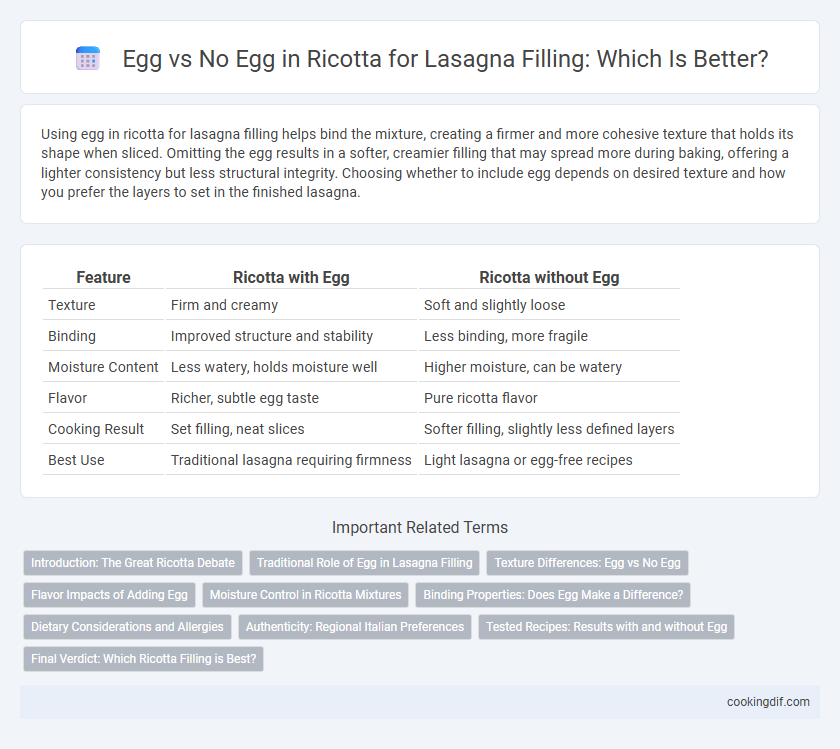Using egg in ricotta for lasagna filling helps bind the mixture, creating a firmer and more cohesive texture that holds its shape when sliced. Omitting the egg results in a softer, creamier filling that may spread more during baking, offering a lighter consistency but less structural integrity. Choosing whether to include egg depends on desired texture and how you prefer the layers to set in the finished lasagna.
Table of Comparison
| Feature | Ricotta with Egg | Ricotta without Egg |
|---|---|---|
| Texture | Firm and creamy | Soft and slightly loose |
| Binding | Improved structure and stability | Less binding, more fragile |
| Moisture Content | Less watery, holds moisture well | Higher moisture, can be watery |
| Flavor | Richer, subtle egg taste | Pure ricotta flavor |
| Cooking Result | Set filling, neat slices | Softer filling, slightly less defined layers |
| Best Use | Traditional lasagna requiring firmness | Light lasagna or egg-free recipes |
Introduction: The Great Ricotta Debate
Ricotta used in lasagna filling varies significantly with or without egg, affecting texture and binding properties. Egg in ricotta enhances firmness and stability during baking, creating a cohesive layer, whereas no-egg ricotta results in a softer, creamier consistency. Chefs and home cooks debate the ideal approach, balancing traditional recipes with desired mouthfeel and moisture control.
Traditional Role of Egg in Lasagna Filling
Egg in ricotta serves as a crucial binding agent in traditional lasagna fillings, providing a creamy texture and helping the layers adhere during baking. Without egg, the ricotta filling can become watery and less stable, often requiring additional ingredients like Parmesan or mozzarella to compensate. This egg-enhanced ricotta mixture preserves the classic consistency and firmness expected in authentic Italian lasagna recipes.
Texture Differences: Egg vs No Egg
Adding egg to ricotta in lasagna filling creates a firmer, more cohesive texture that holds its shape well during baking and slicing. Without egg, the ricotta mixture remains softer and creamier, producing a delicate, slightly looser consistency that melds more fluidly with the layers. The choice between egg and no egg impacts the overall mouthfeel, with egg contributing structure and no egg enhancing a smooth, velvety experience.
Flavor Impacts of Adding Egg
Adding egg to ricotta in lasagna filling enhances creaminess and richness, creating a silkier texture that binds ingredients more effectively. The egg's subtle flavor deepens the overall taste profile, contributing a slightly custardy note that complements savory layers of cheese and tomato sauce. Without egg, the ricotta maintains a lighter, fresher taste but may result in a looser filling consistency and less integrated flavor.
Moisture Control in Ricotta Mixtures
Including egg in ricotta mixtures for lasagna filling enhances moisture control by acting as a binding agent, preventing the cheese from becoming too watery during baking. Egg proteins coagulate when heated, resulting in a firmer, creamier texture that holds its shape better between pasta layers. Ricotta mixtures without egg tend to release more moisture, potentially causing a soggy texture and less structural integrity in the lasagna.
Binding Properties: Does Egg Make a Difference?
Egg in ricotta filling enhances binding properties by creating a firmer, more cohesive texture that prevents the filling from separating during baking. Without egg, ricotta tends to be softer and more prone to oozing, which may result in a looser lasagna structure. The protein in eggs coagulates during cooking, improving stability and sliceability in the final dish.
Dietary Considerations and Allergies
Using egg in ricotta for lasagna filling adds richness and helps bind the mixture, but it may pose challenges for individuals with egg allergies or sensitivities. Egg-free ricotta fillings cater to vegan diets, reduce cholesterol intake, and provide a safer alternative for those with egg-related dietary restrictions. Choosing between these options ensures lasagna recipes accommodate specific allergen concerns and dietary preferences effectively.
Authenticity: Regional Italian Preferences
Traditional Italian lasagna recipes, particularly from regions like Emilia-Romagna, often incorporate egg in ricotta to create a richer, firmer filling that blends well with pasta layers. In contrast, southern Italian variations may omit egg from ricotta, resulting in a lighter, creamier texture that aligns with regional preferences for fresh, delicate flavors. Authenticity in lasagna fillings reflects these regional differences, emphasizing the importance of egg inclusion based on specific Italian culinary traditions.
Tested Recipes: Results with and without Egg
Ricotta fillings with egg create a firmer, creamier texture that holds shape well during baking, as demonstrated in multiple tested lasagna recipes. Ricotta without egg results in a softer, looser filling that can cause a slightly runnier consistency but offers a fresher, lighter taste. Recipes tested show that egg inclusion enhances structural stability, making it ideal for layered lasagna while egg-free versions suit those preferring a more delicate, less dense filling.
Final Verdict: Which Ricotta Filling is Best?
Ricotta filling with egg creates a richer, creamier texture that helps bind the layers of lasagna together, resulting in a more cohesive slice. Ricotta without egg offers a lighter, fresher taste and is ideal for those seeking a softer, less dense filling or an egg-free option. For the best lasagna, using ricotta with egg provides enhanced structure and flavor, especially in baked dishes where firmness is desired.
Egg in Ricotta vs No Egg in Ricotta for filling Infographic

 cookingdif.com
cookingdif.com